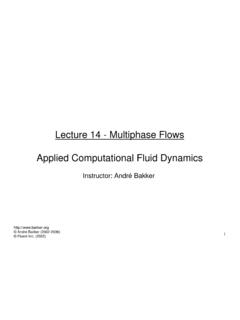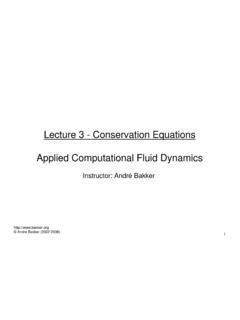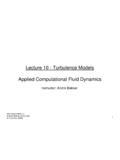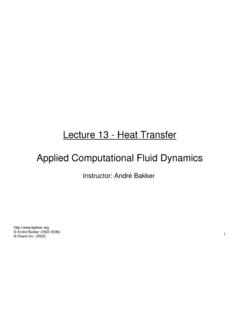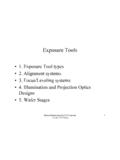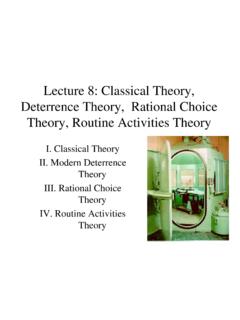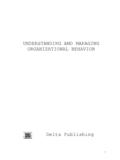Transcription of Lecture 6 - Boundary Conditions Applied …
1 Lecture 6 - Boundary Conditions Applied Computational Fluid Dynamics Instructor: Andr Bakker Andr Bakker (2002-2006). Fluent Inc. (2002). 1. Outline Overview. Inlet and outlet boundaries. Velocity. Pressure boundaries and others. Wall, symmetry, periodic and axis boundaries. Internal cell zones. Fluid, porous media, moving cell zones. Solid. Internal face boundaries. Material properties. Proper specification. 2. Boundary Conditions When solving the Navier-Stokes equation and continuity equation, appropriate initial Conditions and Boundary Conditions need to be Applied . In the example here, a no-slip Boundary condition is Applied at the solid wall. Boundary Conditions will be treated in more detail in this Lecture . 3. Overview Boundary Conditions are a required component of the orifice mathematical model.
2 (interior). orifice_plate and Boundaries direct motion of flow. outlet orifice_plate-shadow Specify fluxes into the computational domain, mass, momentum, and energy. Fluid and solid regions are represented by cell zones. Material and source terms are wall assigned to cell zones. inlet fluid Boundaries and internal surfaces Example: face and cell are represented by face zones. zones associated with pipe Boundary data are assigned to flow through orifice plate face zones. 4. Neumann and Dirichlet Boundary Conditions When using a Dirichlet Boundary condition, one prescribes the value of a variable at the Boundary , u(x) = constant. When using a Neumann Boundary condition, one prescribes the gradient normal to the Boundary of a variable at the Boundary , nu(x) = constant.
3 When using a mixed Boundary condition a function of the form au(x)+b nu(x) = constant is Applied . Note that at a given Boundary , different types of Boundary Conditions can be used for different variables. 5. Flow inlets and outlets A wide range of Boundary Conditions types permit the flow to enter and exit the solution domain: General: pressure inlet, pressure outlet. Incompressible flow: velocity inlet, outflow. Compressible flows: mass flow inlet, pressure far-field. Special: inlet vent, outlet vent, intake fan, exhaust fan. Boundary data required depends on physical models selected. General guidelines: Select Boundary location and shape such that flow either goes in or out. Not mandatory, but will typically result in better convergence. Should not observe large gradients in direction normal to Boundary near inlets and outlets.
4 This indicates an incorrect problem specification. Minimize grid skewness near Boundary . 6. Pressure Boundary Conditions Pressure Boundary Conditions require static gauge pressure pressure inputs: level p absolute = p static + p operating gauge/static pressure The operating pressure input is absolute operating set separately. pressure pressure Useful when: Neither the flow rate nor the operating pressure velocity are known ( buoyancy-driven flows). A free Boundary in an external vacuum or unconfined flow needs to be defined. 7. Pressure inlet Boundary (1). One defines the total gauge pressure, temperature, and other scalar quantities at flow inlets: 1 2. ptotal = pstatic + v incompressible flows 2. k 1 2 k /( k 1). ptotal = pstatic (1 + M ) compressible flows 2.
5 Here k is the ratio of specific heats (cp/cv) and M is the Mach number. If the inlet flow is supersonic you should also specify the static pressure. Suitable for compressible and incompressible flows. Mass flux through Boundary varies depending on interior solution and specified flow direction. The flow direction must be defined and one can get non-physical results if no reasonable direction is specified. Outflow can occur at pressure inlet boundaries. In that case the flow direction is taken from the interior solution. 8. Pressure inlet Boundary (2). For non-isothermal incompressible flows, one specifies the inlet temperature. For compressible flows, one specifies the total temperature T0, which is defined as the temperature that the flow would have if it were brought to a standstill under isentropic Conditions : k 1 2.
6 T0 = TS 1 + M . 2 . Here k is the ratio of specific heats (cp/cv), M is the Mach number, and Ts is the static temperature. 9. Pressure outlet Boundary Here one defines the static/gauge pressure at the outlet Boundary . This is interpreted as the static pressure of the environment into which the flow exhausts. Usually the static pressure is assumed to be constant over the outlet. A. radial equilibrium pressure distribution option is available for cases where that is not appropriate, for strongly swirling flows. Backflow can occur at pressure outlet boundaries: During solution process or as part of solution. Backflow is assumed to be normal to the Boundary . Convergence difficulties minimized by realistic values for backflow quantities. Value specified for static pressure used as total pressure wherever backflow occurs.
7 Pressure outlet must always be used when model is set up with a pressure inlet. 10. Velocity inlets Defines velocity vector and scalar properties of flow at inlet boundaries. Useful when velocity profile is known at inlet. Uniform profile is default but other profiles can be implemented too. Intended for incompressible flows. The total (stagnation). properties of flow are not fixed. Stagnation properties vary to accommodate prescribed velocity distribution. Using in compressible flows can lead to non-physical results. Avoid placing a velocity inlet too close to a solid obstruction. This can force the solution to be non-physical. 11. Outflow Boundary Outflow Boundary Conditions are used to model flow exits where the details of the flow velocity and pressure are not known prior to solution of the flow problem.
8 Appropriate where the exit flow is close to a fully developed condition, as the outflow Boundary condition assumes a zero normal gradient for all flow variables except pressure. The solver extrapolates the required information from interior. Furthermore, an overall mass balance correction is Applied . 12. Restrictions on outflow boundaries Outflow boundaries cannot be Do not use outflow boundaries used: where: With compressible flows. Flow enters domain or when With the pressure inlet Boundary backflow occurs (in that case condition (use velocity inlet use pressure ). instead) because the Gradients in flow direction are combination does not uniquely significant. set a pressure gradient over the Conditions downstream of exit whole domain. plane impact flow in domain.
9 In unsteady flows with variable density. outflow outflow outflow outflow condition condition condition condition closely ill-posed 13. not obeyed obeyed obeyed Modeling multiple exits Using outflow Boundary condition: Mass flow divided equally among all outflow boundaries by default. Flow rate weighting (FRW) set to one by default. For uneven flow distribution one can specify the flow rate weighting for each outflow Boundary : mi=FRWi/ FRWi. The static pressure then varies among the exits to accommodate this flow distribution. FRW1. velocity inlet FRW2. Can also use pressure outlet boundaries to define exits. pressure-outlet velocity-inlet (v,T0) (ps)1. or pressure-inlet (p0,T0). pressure-outlet (ps)2 14. Other inlet and outlet Boundary Conditions Mass flow inlet.
10 Used in compressible flows to prescribe mass flow rate at inlet. Not required for incompressible flows. Pressure far field. Available when density is calculated from the ideal gas law. Used to model free-stream compressible flow at infinity, with free- stream Mach number and static Conditions specified. Exhaust fan/outlet vent. Model external exhaust fan/outlet vent with specified pressure jump/loss coefficient and ambient (discharge) pressure and temperature. Inlet vent/intake fan. Model inlet vent/external intake fan with specified loss coefficient/. pressure jump, flow direction, and ambient (inlet) pressure and temperature. 15. Determining turbulence parameters When turbulent flow enters domain at inlet, outlet, or at a far-field Boundary , Boundary values are required for: Turbulent kinetic energy k.
